
photo by hoge asdf
Japan’s symbol ‘Mt. Fuji’. At 3776 meters, it is Japan’s tallest mountain. Mt. Fuji has the meaning of ‘immortality (non-death)’ and ’singularity (no two)’, and that beautiful form has been revered as a symbol of worship for a long time. And one of the appeals of Mt. Fuji is that even if you have no mountain climbing experience, but have average physical strength, you can reach the summit. In fact, since being designated as a World Heritage Site in June of 2013, approximately 300,000 people have climbed Mt. Fuji just during the 2 summer months period! Nonetheless, Mt. Fuji is Japan’s highest peak. Can first-time mountain climbers really climb it? We looked into it.
Hiking season for Mt Fuji is summer only!
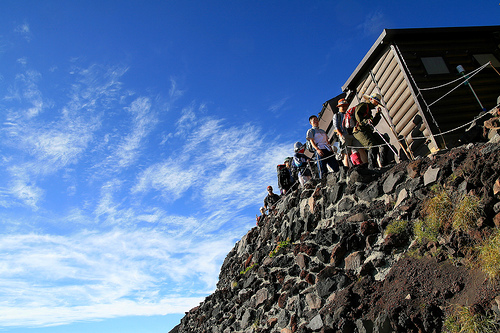
photo by skyseeker
Firstly, Mt Fuji’s climbing season is the beginning of July ~ until mid September. It is fine for beginners during this time because climbing buses are running, there are public restrooms and stores, and mountain huts where one can stay. It is relatively uncrowded in July, but because of the East Asian rainy season in the first half of the month it changes the weather for the worse, so it is recommended first-timers climb after rainy season has ended, in late July. From late July to mid-August, once it’s the summer holiday, it is very crowded. Especially weekends and the time of Obon, the trails are overflowing with climbers. You want to see the sunrise at the summit, but it’s so crowded that you can’t go any further. On the other hand, you want to take your time climbing but you’re urged from behind to move faster. September is the secretly known best time to climb because it settles down, but it is the beginning of the harsh weather season so be prepared with insulated clothing. Be thorough in your preparation of what to bring. By the way, unless you are a very experienced climber, climbing in times other than climbing seasons is very dangerous .
Essentials to bring when climbing Mt. Fuji
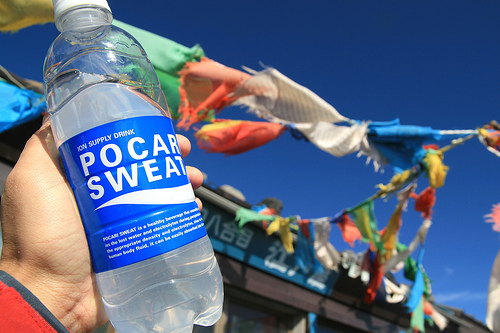
photo by skyseeker
Because you’re a beginner, be sure to properly check your equipment.
- Packs (Climbing pack / Backpack)
- Headlamp with extra batteries
- Hiking route map
- Trekking shoes
- Rainwear/raingear
- Insulated clothing
- Cotton gloves
- Food/Drink
- Change (100 yen coins)
- Toilet paper
If you thought, what’s the change for? It’s for the public restrooms that are pay-per-use (100-300yen). Also don’t forget the mountain climbing fee. Climbers who head to the summit from the fifth station should pay the mountain climbing fee of 1000yen. Please be sure to pay it since it is for the environmental conservation of Mt. Fuji fund.
Popular climbing routes rankings and characteristics
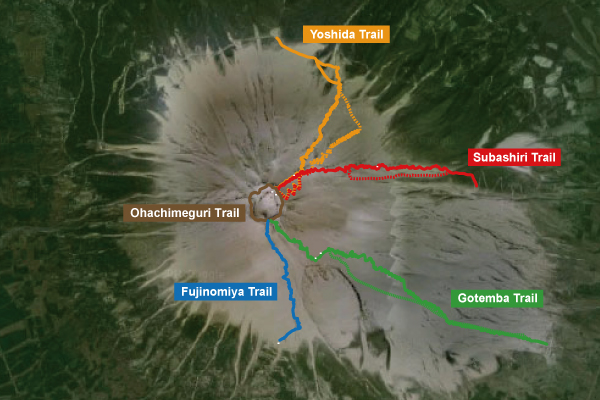
Mt Fuji has 4 climbing routes. Since each one has different features, pick the route best suited for you.
Popularity ranking #1 Yoshida climbing route
The most popular climbing route is the yellow Yoshida climbing route.
- Many hikers and most lively
- Has the most stores, mountain huts and first aid stations so thoughtful of beginners
- Roads are well maintained so easy to walk on
- Most recommended route for beginners
| Starting point altitude (fifth station) | ▶ 2305m |
| Walking distance | ▶ Ascent: 7.5km ▶ Descent:7.6km |
| Duration (without breaks) | ▶ Ascent: Approximately 6 hours ▶ Descent: Approximately 3 hours and 20 mins |
| Mountain hut numbers | ▶ 18 |
Popularity ranking #2 Fujinomiya climbing route
The second most popular climbing route is the blue Fujinomiya climbing route
- Shortest route to the summit
- Hiking trail is narrow, so need to be courteous
- Overall slope is steep, with many rocky areas
| Starting point altitude (fifth station) | ▶ 2400m |
| Walking distance | ▶ Ascent: 5.0km ▶ Descent:5.0km |
| Duration (without breaks) | ▶ Ascent: Approximately 5 hours ▶ Descent: Approximately 2 hrs 40 mins |
| Mountain hut numbers | ▶ 9 |
Popularity ranking #3 Subashiri climbing route
Third most popular ranked climbing route is the red Subashiri climbing route
- When you first start climbing, the course is covered in green so feels lovely
- Merges with the Yoshidaguchi course so tends to get crowded at the eighth station
- Can descend quickly because the sand run on the descending trail is easy on the knees
| Starting point altitude (fifth station) | ▶ 2000m |
| Walking distance | ▶ Ascent: 7.8km ▶ Descent:6.2km |
| Duration (without breaks) | ▶ Ascent: Approximately 5hrs 40mins ▶ Descent: Approximately 2hrs 30mins |
| Mountain hut numbers | ▶ 12 |
Popularity ranking #4 Gotenba climbing route
Fourth most popular ranked climbing route is the green Gotenba climbing route
- Hiking course is insanely long
- Only a few mountain huts (means less restrooms)
- Not many hikers so doesn’t get that crowded
| Starting point altitude (fifth station) | ▶ 1440m |
| Walking distance | ▶ Ascent: 11.0km ▶ Descent:8.5km |
| Duration (without breaks) | ▶ Ascent: Approximately 7hrs 30mins ▶ Descent: Approximately 3hrs 10mins |
| Mountain hut numbers | ▶ 5 |
Mt. Fuji climbing routes map English version
Mt. Fuji climbing routes map is here
Access to Yoshida climbing route entrance, recommended for beginners
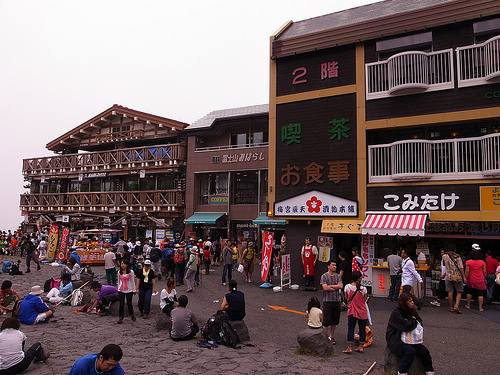
photo by Banzai Hiroaki
If you take the train, you’ll probably get tired from all the transfers, so here’s an introduction on how to get there by highway express bus. It might take a little longer, but the fare is cheap, departs at night and arrives the next morning (can sleep until you arrive), so is probably the best option. From Tokyo, you can take the highway express bus from Shinjuku station to get to the climbing route entrance directly, so it’s convenient.
From Tokyo | Shinjuku Sta. ~ Fuji Subaru Line Fifth Sta.
1. Direct highway express bus from Shinjuku Sta. ~ Fuji Subaru Line Fifth Sta. Yoshidaguchi
Duration: Approx. 2hrs 30 mins
Adult fare: One-way 2700yen / Child fare: One-way 1350 yen
From Osaka | Osaka Sta. ~ Mt Fuji Sta. ~ Fuji Subaru Line Fifth Sta.
1. Highway express bus from Osaka Sta. ~ Mt Fuji Sta.
Duration: 11 hours
Adult fare: One-way 8700yen / Child fare: One-way 4350 yen
2. Route bus from Mt Fuji Sta. ~ Fuji Subaru Line Fifith Sta. yoshidaguchi
Duration: 45 minutes ~ 1 hour 5 minutes
Adult fare: One-way 1540 yen / Child fare: One-way 770 yen
From Kyoto| Kyoto Sta. ~ Mt Fuji Sta. ~ Fuji Subaru Line Fifth Sta.
1. Kyoto Station ~ Mt Fuji Sta. highway express bus
Duration: 9 hours and 20 minutes
Adult fare: One-way 8200 yen / Child fare: One-way 4100 yen
2. Route bus from Mt Fuji Sta. ~ Fuji Subaru Line Fifth Sta. Yoshidaguchi
Duration: 45 minutes ~ 1 hour and 5 minutes
Adult fare: One-way 1540 yen / Child fare: One-way 770 yen
For reservations or questions, go here
Fuji Express Bus
Mt. Fuji’s climbing schedule in 2 days 1 night
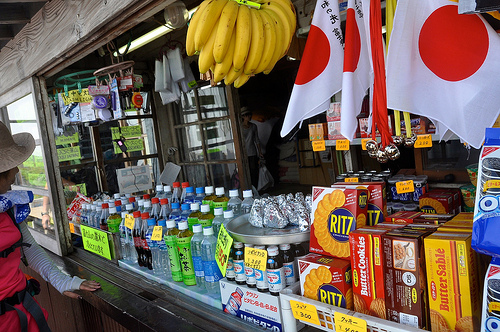
photo by Banzai Hiroaki
To climb Mt. Fuji, plan for a two days one night stay. There seem to be people who do the whirlwind climb-in-a-day tour, but for beginners it is best to take your time to let your body adjust to the altitude.
1st day
Arrive at fifth station climbing route entrance ~ Eighth station mountain hut
Arrive at the fifth station climbing route entrance. After lunch, start climbing from the entrance of the fifth station, arrive at the Eighth station mountain hut around dinnertime, dinner and nap at the mountain hut.
2nd day
Eighth station mountain hut ~ summit ~ descent
Depart for the summit around 2:00 in the morning. Arrive around 4:30am at the summit, pay respects to the sunrise and then descend. As such is the typical climbing itinerary.
Yoshida Climbing Route List of mountain huts past the Seventh Station
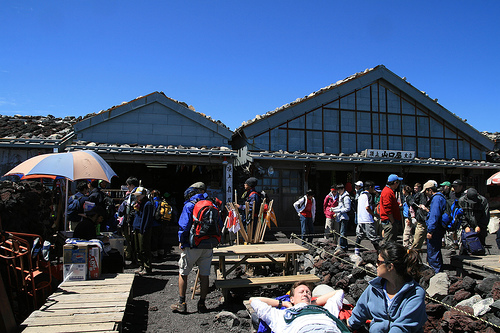
photo by skyseeker
On the weekends and around the time of Obon the mountain huts near the summit get fully booked several months in advance, so be sure to make reservations early. Lodging fee is 5000-8500 yen. A stay without meals or an overnight stay with 2 meals are the two pricing points. Prices increase on weekends and holidays for both. The bedroom is either the big room or the private rooms, but either way you are sleeping in shared sleeping bags or futons, so if you want to sleep comfortably you might want to bring your own sleeping bag.
| Hut Name | Location | With meals | Without meals | Telephone |
|---|---|---|---|---|
| Hana Koya | 7th Sta | 7800 yen | 5800 yen | 090-7234-9955 |
| Hinodekan | 7th Sta | 7800 yen | 5800 yen | 0555-24-6522 |
| Tomoekan | 7th Sta | 7800 yen | 5800 yen | 0555-24-6521 |
| Kamaiwakan | 7th Sta | 8200 yen | 6100 yen | 080-1299-0223 |
| Fujiikkan | 7th Sta | 7800 yen | 5600 yen | 080-1036-6691 |
| Toriisou | 7th Sta | 7000 yen | 5000 yen | 0555-84-2050 |
| Touyoukan | 7th Sta | 8200 yen | 6100 yen | 0555-22-1040 |
| Taikokan | 7th Sta | 8500 yen | - | 0555-24-6516 |
| Horaikan | 8th Sta | 8500 yen | - | 0555-24-6515 |
| Hakuunsou | 8th Sta | 7800 yen | 5800 yen | 0555-24-6514 |
| Gansoushitsu | 8th Sta | 7800 yen | 5600 yen | 0555-24-6513 |
| Mt Fuji Hotel | 8th Sta | 8300 yen | 5950 yen | 0555-24-6511 |
| Tomoekan | 8th Sta | 7800 yen | 5800 yen | 0555-24-6511 |
| Goraikoukan | 8.5th Sta | 7500 yen | 5500 yen | 0555-22-7751 |
Climbing Mt Fuji is a priceless experience!
Sunrise ‘Thank you, sun!’
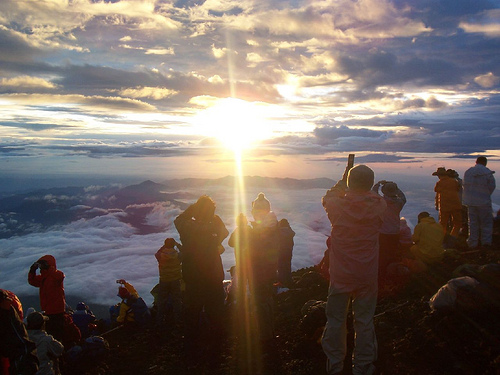
photo by Hajime NAKANO
The sunrise that rises from a sea of clouds. It’s not an exaggeration to say that you chose to suffer and climb for this one moment. Feel free to immerse yourself in that beautiful scenery for a while.
Send a letter from the summit! Mt Fuji Summit post office.
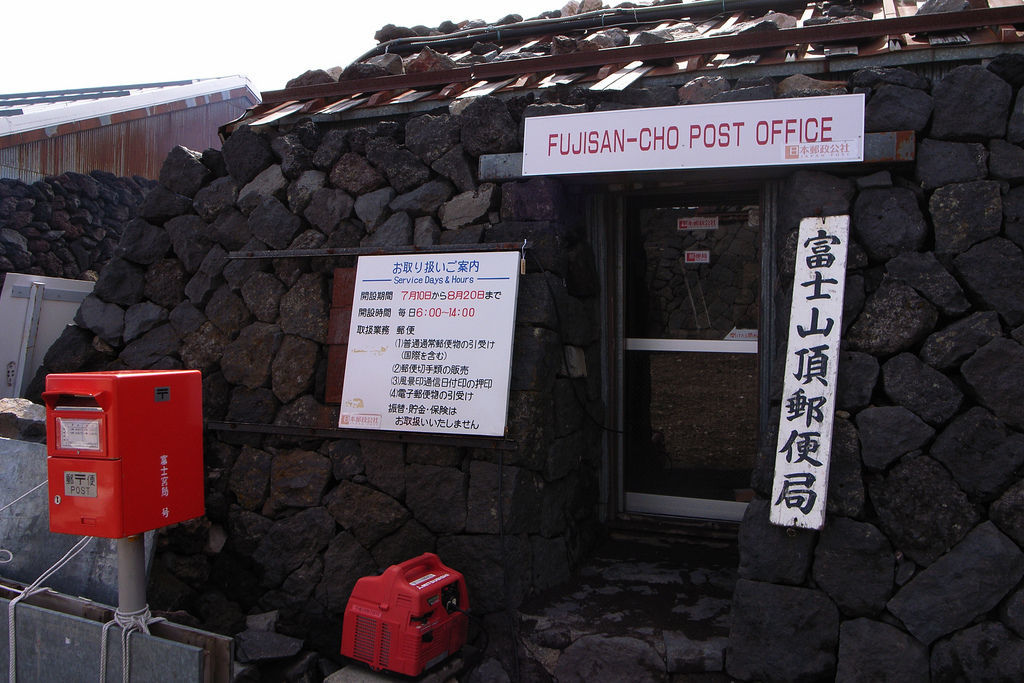
photo by Sig.
At the summit of Mt Fuji, there is a post office. A climbing certificate or a an official certificate for climbing to the summit of Mt Fuji and original seals are just some of the things you can get to remind yourself of this memory.
In closing
They say that even children are able to climb Mt Fuji, but do be careful because there is always the risk of high altitude sickness if you push yourself too hard. To prevent altitude sickness, take 10 minute breaks every 50 minutes. If you get tired, stop and take deep breaths. And if you get careless when you descend and take the wrong route, you won’t be able to go back. (Formally you will be able to return, but it might not seem like it) Be sure to properly check the signs at the crossroads. Safety first! Please everyone have fun climbing Mt Fuji safely!
